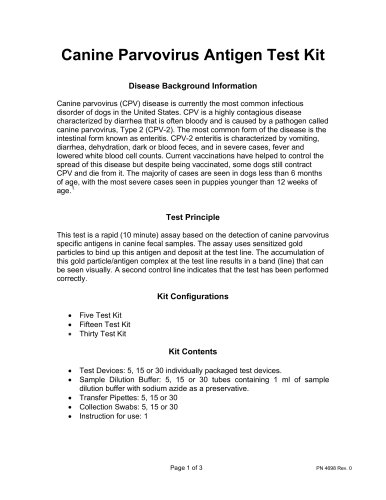
Catalog excerpts

Canine Heartworm Antigen Test Kit I. Disease Background Information Dogs are considered the definitive host for heartworms, known by the scientific name of Dirofilaria immitis. However, heartworms may infect more than 30 species of animals, including humans. This worm is transmitted when a mosquito carrying infective heartworm larvae bites a dog. The larvae grow, develop, and migrate in the body over a period of several months to become sexually mature male and female worms. These worms reside in the heart, lungs, and associated blood vessels. Even as immature adults, the worms mate and the females release their offspring, known as microfilariae, into the blood stream. The time elapsed from when the larvae enter the dog, until the minute offspring can be detected in the blood (pre-patent period), is about six to seven months. II. Test Principle This test is a rapid (10 minute) assay based on the detection of adult female Dirofilaria antigen present in the dog’s serum, plasma or anticoagulated whole blood (EDTA or heparin). The assay uses sensitized gold particles to bind up this antigen and deposit at the test line. The accumulation of this gold particle/antigen complex at the test line results in a band (line) that can be seen visually. A second control line indicates that the test has been performed correctly. 5, 15, 30 or 50 pouches containing test devices 5, 15, 30 or 50 transfer pipettes 1 dropper bottle containing 6 mL of chase buffer Instructions for Use Use the kit before the expiration date stamped on the kit box. Store the kit between 2 ºC and 7 ºC (36 ºF to 45 ºF). Allow the kit to come to room temperature 15 ºC to 25 ºC (59 ºF to 77 ºF) before using. Open the pouch containing the device immediately before use. Run the test on a flat, horizontal surface. Hold the sample pipette and chase buffer vertically when adding reagents to the sample window of the test device. Do not touch the white membrane surface at any time. This could tear the membrane resulting in an inaccurate test. Add only the correct amount of sample and chase buffer to the device. Chase buffer contains sodium azide as a preservative. V. Test Procedure 1. Bring kit and its contents to room temperature. 2. Tear open the pouch and place the test device on a flat, horizontal surface. 3. Using provided transfer pipette, aspirate sample and dispense 1 drop to the sample window by squeezing the bulb on the transfer pipette. (Diagram 1) 4. Immediately add 2 drops of chase buffer to the sample window. (Diagram 2) 5. Set timer for 10 minutes, start timer after addition of chase buffer. (Diagram 3) 6. Interpret results after 10 minutes. (Diagram 4) CAUTION: Do not deviate from the above procedure. Deviations will compromise test performance
Open the catalog to page 1
VI. Reading Results (Diagram 4) Hold sample at a comfortable distance from the eyes under adequate light so that the line(s) are clearly visible. VII. Interpretation Refer to Diagram #4 in this instruction manual. o If two lines are visible (one at the test line and one at the control line) - the sample is positive. o If one line is visible (ONLY at the control line) - the sample is negative. o If no lines are visible, or if only one line is present at the test position (but not the control position), the test is invalid and must be rerun. For Technical Service: Tel: (760) 929-7744 Fax:...
Open the catalog to page 2

